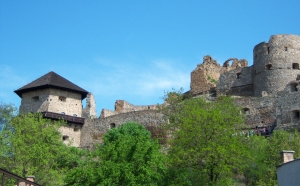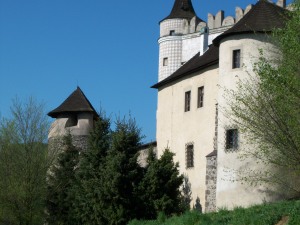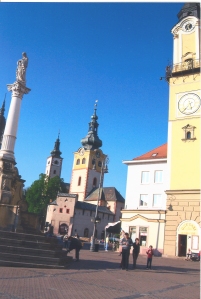CC BY-SA 3.0 File:Slovakia Regions map.png Created: 27 April 2010
Slovakia borders Ukraine, Poland, Czech Republic, Austria and Hungary.
Slovakia is scheduling trains out of Ukraine to Slovakia to transport refugees. https://rubryka.com/en/2022/03/09/slovachchyna-pryznachyla-shhodenni-poyizdy-dlya-vyvozu-bizhentsiv-z-ukrayiny/
 High Tatra mountains, Slovakia – Poland
High Tatra mountains, Slovakia – Poland
Cross the border from Slovakia after the town of Levoca, and aim for Poland. Suddenly the landscape is alpine, a place to stay is just over there, but it is still so light, we can go on just a bit further.
So we did, and almost regretted it. Our destination was the Polish town of Zakopane, known for hiking and skiing. Surely it would be no problem. We are too accustomed to gas on demand, and lighting where we want to go.
But dark comes quickly; and the tank plummets. Moral: to avoid travel anxiety, gauge the daylight carefully before heading into mountains. We were fine, but had no idea now much farther we had to go.
High Tatras. The scenery recalls World War films of running people, dogs barking, fear. Such is the power of early visual image, association. High Tatras, border Slovakia to Poland
High Tatras, border Slovakia to Poland
Are these particular photos from across the border into Poland already? My notes are not clear. We do have a Poland Road Ways, and also posted these there.
The name “Tatra” — big, black Tatras, in which the officials rode: a Czech company, see http://home.clara.net/peterfrost/tatra.html. See the novels recounting the experience of an overlooked minority, the Roma, the gypsies. Zoli, novel by Colum McCann. Meet a Roma singer and dancer, who allowed glimpses into the culture, and was banned for it. See http://www.goodreads.com/book/show/110894.Zoli/ Next, take out Fires in the Dark, by Louise Doughty: a family of Roma in Slovakia caught with others of their community, in the quotas for the WWII labor camps. See http://www.goodreads.com/book/show/307210.Fires_in_the_Dark
The Inquisition, the hunting down of autonomous believers or nonbelievers, any whose mindsets or acts did not conform to the Roman Catholic teaching, was part of medieval Central and Western Europe for centuries. Following: repercussions. See http://www.jewishvirtuallibrary.org/jsource/History/Inquisition.html. It did not expand into the Scandinavian countries or Great Britain to the same degree, but individuals and movements followed suit in their way.

Levoca, Slovakia. History of women in Europe. Inquisition memorial, persecution, witchcraft, heresy. Statue: woman and child. Woman and child column. Church behind.
The Cage, one of the few remaining from the Inquisition era, is nearby. The influence of the Inquisition, now a book, see God’s Jury – the Inquisition and the Making of the Modern World by Cullen Murphy, NYT review by Samuel Freedman at http://www.nytimes.com/2012/01/29/books/review/gods-jury-the-inquisition-and-the-making-of-the-modern-world-by-cullen-murphy-book-review.html
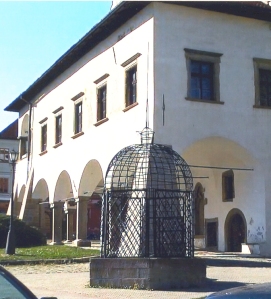
Levoca, once part of Hungary, offers a glimpse into the social and religious control mechanisms for women. This, a 16th century cage for women.
See history of Levoca at http://www.tatry.sk/en/historic-sights/levoca. Social controls over autonomy. Looking at the ease with which western and other cultures exploit women and restrict their autonomy, including through trafficking, ask how selected interpretations of ambiguous or even missing texts, and dogma, foster social power goals. Connect?

Currently, The town of Levoca, Slovakia, entitles this cage in a benign, tut-tut way, as a “Cage of Disgrace” to encage women accused as scolds, or some mild fake equivalent. This belies its own heritage as suppressor of an entire gender’s indivuality. This was the era of Inquisition where women were burned for heresy and healing outside the established male bounds of “The Church.” See The Burning Time, and do not be deceived by labels as to mere “scolds.”
?
Visit Slovakia and find echoes and roots of current and past exploitation of women, the dark undercurrent of the world’s major cultures. Explore Slovakia and human trafficking. It is not alone. The United Nations his is not a merely feminist issue, see http://www.unodc.org/unodc/en/human-trafficking/index.html.
Roots of power, entrenched and fertilized by cages of disgrace that keep competition out.
This gender idea so prominent in the Inquisition.
Is it still such fair game if she speaks up, asserts autonomy, finds another interpretation of scripture as to her role in the life of the world, differing from the male institution. Is this what google does not find amenable to its advertisers, its marketing opportunities, so it blocks the speech of those advertisers do not find lucrative. Are big corporations more to be feared than big government, because corporations are in or way accountable. See kngdv at blogspot, or vetting roots at blogspot for any interest you may have in vetting dogma. Keep your head down. But look. Hush. The looters are out. The Burning Time, see http://www.amazon.com/The-Burning-Time-Robin-Morgan/dp/193363300X. The Malleus Maleficarum, at http://www.malleusmaleficarum.org/. Are these what google did not want shown ona mere travel site? Ah, so.
 Taking the high ground can mean morally, as cultures without survival at stake can use the phrase; or as a defense, where those who are subject to invasions can necessarily use the term: the physical advantage of being literally above the enemy, for purposes of projectiles, and fatiguing the enemy.
Taking the high ground can mean morally, as cultures without survival at stake can use the phrase; or as a defense, where those who are subject to invasions can necessarily use the term: the physical advantage of being literally above the enemy, for purposes of projectiles, and fatiguing the enemy.
Spis Castle is the physical high ground, a prominent marker and bulwark against Ottoman and other invaders, a crossroads of trade routes so the visibility mattered to the lost or threatened. It occupies a huge footprint.
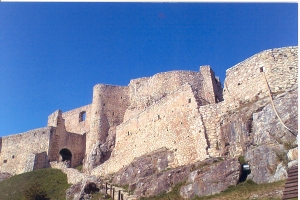
Spis Castle, Slovakia, occupies a site with habitation for over millennia. This site claims people living here 40,000 years ago. As a medieval fortress, it was rock built on rock by 1249, see http://www.spisskyhrad.sk/en.html.
Opening and closing times may not correlate with the guide book. Arrive nowhere at 4PM, expecting an hour to go. We literally had to run inside at 4, expecting a 5PM closing, and run around to get our views of this wonderful place. There was construction-renovation going on, and the construction-renovation schedule for workers superseded anything tourist.
The Ottoman Expansion in the 16th Century put Slovakia in line for conquest after the invasion of Hungary, just to the south. The castle at Filakovo as fortified is intended as a bulwark against invasion, and remained such: without renovation into Renaissance or other later style. It has not served as a mere residence. It may have been built by the Kacsics clan in the 13th century, see http://slovakia-travelguide.info/filakovo.html. We stopped there on our way from Zvolen to Kosice.
Stop to buy a snack in a local supermarket in this mid-size town, and find an element of the old police state.
I tried to photograph my son at the cashier conveyor belt, just to show the fine variety of things to buy. Immediately appeared a policewoman, in uniform and cap and waving at us with both hands, away and pointing to the camera, shaking her head, nonono. We tried to show we just wanted a simple photo, and finally left.
The coat of arms for Filakovo shows a palm tree. Where does that come from? See http://www.fotw.net/flags/sk-lc-fi.html. The history of cultural groups, see http://www.spiritus-temporis.com/slovakia/history.html, does not suggest tropical origins. The formal Slovak coat of arms shows a lime leaf, but not a palm as at Filakovo, see http://www.slovak-republic.org/symbols/
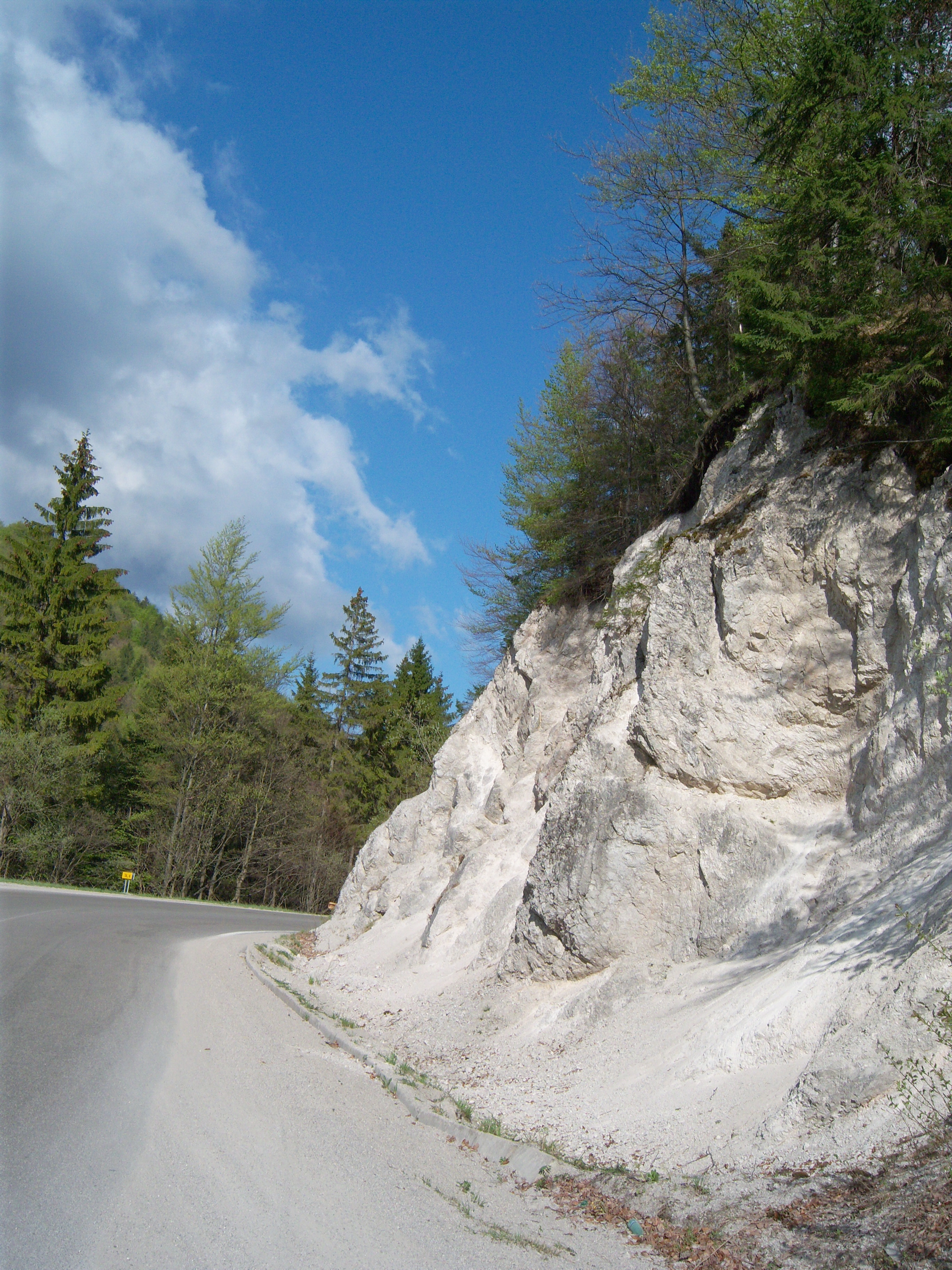
Salt karst is a geological formation serving economic and health interests: karst salt caves good for asthma? Here, roadside deposit, toward Kosice, Slovakia.
Find the health overview at http://spectator.sme.sk/articles/view/27566/3/. The term for uses of karst salt is speliology.Salt therapy aids in mucous dilution, see http://www.forbes.com/2009/09/21/europe-travel-gems-lifestyle-travel-europe-sightseeing_slide_9.html.
Cave systems including salt caves are listed at http://www.slovakiasite.com/caves.php.
Slovak karst is specifically noted at karst-sites — see http://www.websters-online-dictionary.org/definitions/Slovak+Karst?cx=partner-pub-0939450753529744%3Av0qd01-tdlq&cof=FORID%3A9&ie=UTF-8&q=Slovak+Karst&sa=Search#906. Are we allowed to provide a direct link? Why not. This is just an address. If they choose to let you in the door, fine. If they do not want you in the door, they can lock it.
There is an older ruin of a castle at Zvolen, with an original area at its glory days, of some 175 acres — 7 hectares, at about 2.5 acres per hectare. It was finally burned by John Hunyadi in 1452. The Hungarian Hunyadi had fostered Vlad Tepes, Dracula, a captivity really in order to secure the performance of Vlad’s father in a treaty arrangement — see Hunyadi’s castle in Romania at http://romaniaroadwaysvladtepes.blogspot.com/2006/08/hunedoara-johan-hunyadi-vlad.html.
Its importance was eclipsed despite rebuildings, when a new castle was built in the town. This area of Slovakia was part of northern Hungary at the time.

Castle at Zvolen, Slovakia. Many castles in Slovakia remain rugged fortresses, to defend against the many invaders — Turks, Tatars.
Later remodelings added the crennelations, the decorations looking rather Renaissance. See history at http://eng.zvolen.eu/history.phtml?id3=5227
Zvolen Castle, from rugged defense needs, to the Renaissance. See video at http://www.youtube.com/watch?v=6R0AAIoK9-Q. You may want to turn down the sound a little.



